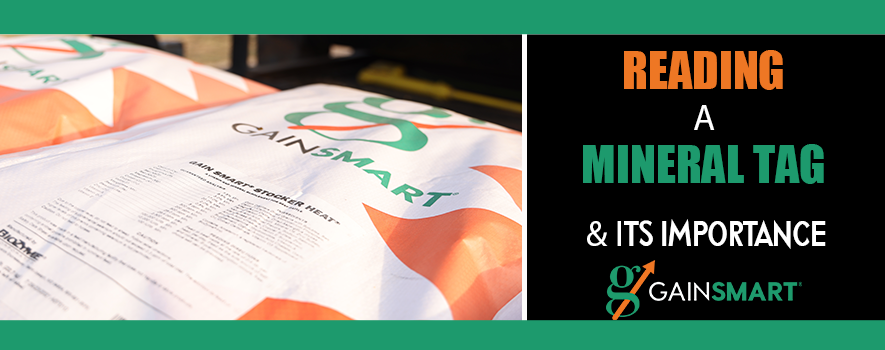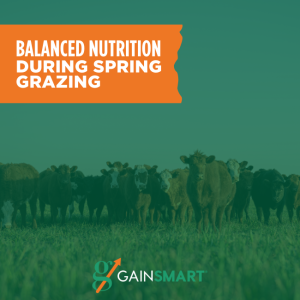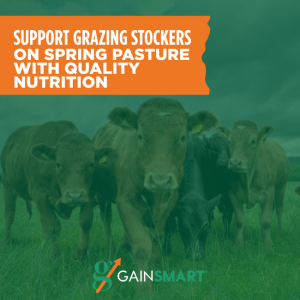Chris Cassady, Ph.D., BioZyme® Beef Technical Sales Manager

Information is power. However, if you don’t use the information in front of you, you could remain powerless. That is why it is important to know how to read the tag that comes on mineral bags and what to do with all that information to best determine the nutritional management of young calves that you recently turned out. Once you use that information currently, you are likely to minimize the risk of sickness and morbidity and increase the potential for growth and profit.
When grazing stockers on grass and wheat pasture the most important ingredients to look for on a mineral tag include chelated copper and zinc. Zinc helps support the overall health of the calves, promote foot health and prevent foot rot, and copper is so deficient in many areas where that mineral is needed.
Although the ingredient content of the mineral tag is the most important part of the tag, it is just one component of the tag. Let’s examine a typical mineral tag from top to bottom.
Product Name. Although this seems simple, it is important to pay attention to, as many similar products may just have one or two words different in their names. For example, the Gain Smart® line for stocker calves has four products, two of which are Gain Smart Stocker and Gain Smart Stocker HEAT®. Although the products would work for any stockers grazing grass pasture, there are other formulas designed for feeding grain – Gain Smart Balancer RU1600 – and for grazing wheat – Gain Smart Wheat – so it is important to pay attention to the name on the label.
Purpose Statement. The purpose statement is required on all labels and must be followed. If the label on a mineral tag states that it is a mineral for beef cattle in the growing phase, then that is the species and the production phase it is meant to be fed to. Don’t try to feed it to lactating ewes.
Guaranteed Analysis. This is a breakdown of the nutrients in the mineral. This is often the only thing salespeople will show a customer, but as the feeder you also need to know what other nutrients the animal is getting so you don’t miss anything important in the diet. The guaranteed analysis is useful in comparing nutrient levels and relative prices of products. However, it does not tell you everything, as the sources of nutrients are also very important. Don’t be fooled by only looking at levels. Understand the needs of the animal and the nutrient sources. Another tip is that the trace mineral ratios are often as important as any one nutrient level due to the interactions between trace minerals like calcium, phosphorous, copper, zinc, sulfur and other antagonists. These can easily make any level unavailable to the animal.
Ingredient List. This is the most important part of the tag because it does include all ingredients in the mineral. Consider when comparing labels that feed regulations allow for the use of generalized terms. For example, it can be listed as plant protein products rather than soybean meal. Many companies like to use generic terms because it allows them the flexibility to reformulate without redoing labels when ingredient prices drop. This allows them to substitute other ingredients and hit the same guaranteed percent. One example of this would be creep feeds that are often fed as energy supplements. There is no guarantee for energy on the tag, and if you can’t see exactly what ingredients are being used, how do you know with confidence that the feed has more energy than the hay the cattle are consuming in the pasture?

It is important to remember that ingredients are listed in the order of those with the greatest inclusion in the product. So, the further down the label an ingredient is listed, the less of that ingredient there is included. If you are trying to feed your animals a high protein supplement, make sure that protein is one of the first listed ingredients or your product isn’t benefitting your animals.
Understanding an ingredient list means needing to know the value of the ingredients used. A lot of information is available about different trace mineral sources and other ingredients. If you are not sure about the ingredients listed, reach out to a trusted nutritionist or salesperson.
Feeding Directions. This is another important part of the tag, as it will direct you on how to deliver the product to your livestock. However, when feeding a free-choice mineral, it is safe to calculate an average amount over a specific time. Since calves can’t read or measure out 2-4 ounces per day, they will usually level out at that intake level if they are not deficient in a specific nutrient. If you feel overconsumption is happening, feel free to provide free-choice salt close to the mineral feeder. Just remember that mixing salt in the mineral will dilute the product you’re intending to deliver and the implications that may have for cattle with lower mineral intakes.
Caution Statements. This fine print should not be ignored. For example, if a mineral contains copper, it will likely advise against feeding to sheep. Heed this advice. It is typically in the producer’s best financial and operational interest to follow all label directions.
Manufacturer Information. This lists who the manufacturer is or if the company marketing the product had another company manufacture the product for them, in which case it might list “manufactured by and for the company doing the marketing.”
Weight. Most mineral comes in 50-pound bags. The Gain Smart products comes in woven poly bags that are waterproof and recyclable.
Manufacturing Practices Statement. This statement describes the manufacturing practices followed by the manufacturer that are good for the animal and for the environment.
That’s a lot of information to decipher on a small mineral tag, but it is most important to know what your mineral is, what is in it and how to feed it to get maximum performance from your stocker calves.
One of the primary advantages of the Gain Smart mineral line is that it contains the prebiotic Amaferm®. Amaferm works to maintain gut health, increasing the overall health of your animal. Healthier animals mean a reduced need to treat with antibiotics, often helping keep them in all-natural programs. Our customers benefit from the natural ingredients in Gain Smart, see faster, more efficient gains and typically treat fewer sick cattle.
To learn more about the advantages of Gain Smart of to locate a dealer near you, visit www.gainsmart.com.

